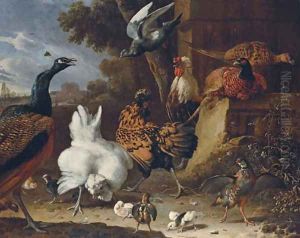Melchoir D'Hondecoeter Paintings
Melchior d'Hondecoeter, born in Utrecht, the Netherlands, in 1636, was a Dutch painter known for his dynamic and detailed depictions of birds and other wildlife within their natural habitats. He came from a family of artists; his father, Gijsbert d'Hondecoeter, and his uncle, Jan Baptist Weenix, were both painters who had a significant influence on his work. Melchior specialized in portraying birds with remarkable precision and liveliness, which made his work highly sought after during the Dutch Golden Age.
D'Hondecoeter began his artistic training with his father and later with his uncle in Amsterdam, where he moved early in his career. His paintings often featured domesticated birds like peacocks, ducks, and chickens, as well as exotic species such as parrots and flamingos, which were becoming more common in Europe due to the expanding trade routes and colonial exploration of the time. He was particularly adept at capturing the textures of feathers and the nuances of animal behavior, which set his work apart from that of his contemporaries.
Throughout his career, d'Hondecoeter produced a vast body of work that included grand, large-scale pieces commissioned by wealthy patrons, as well as smaller studies. His ability to depict the birds against complex backgrounds showcasing gardens, parks, or palatial estates added an element of storytelling to his work. Melchior d'Hondecoeter's paintings were not only appreciated for their artistic merit but also for their contribution to the study of ornithology, providing visual documentation of bird species and their behavior.
D'Hondecoeter's reputation grew, and he became a member of the painters' guild in The Hague. Despite his success, there is little documentation about his personal life. He continued to work and live in Amsterdam until his death in 1695. Today, his work can be found in major museums around the world, including the Rijksmuseum in Amsterdam and the Louvre in Paris, where they continue to be admired for their vivid realism and the skillful representation of nature.
